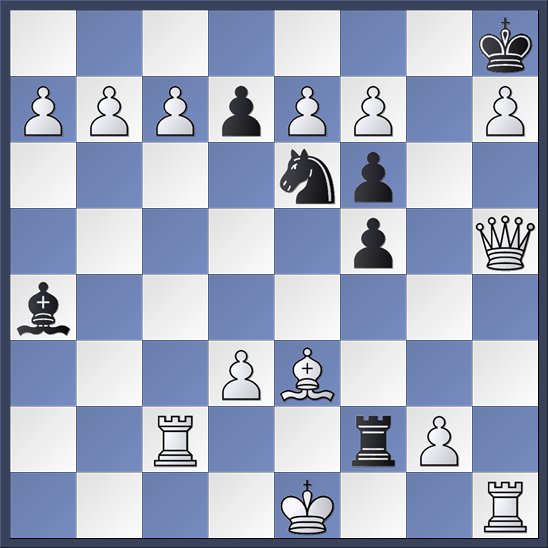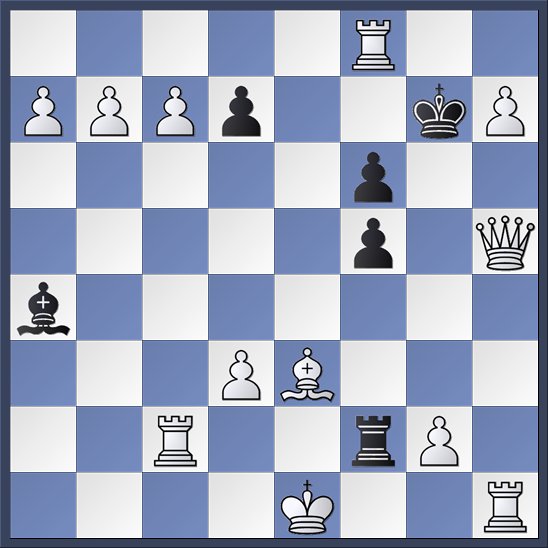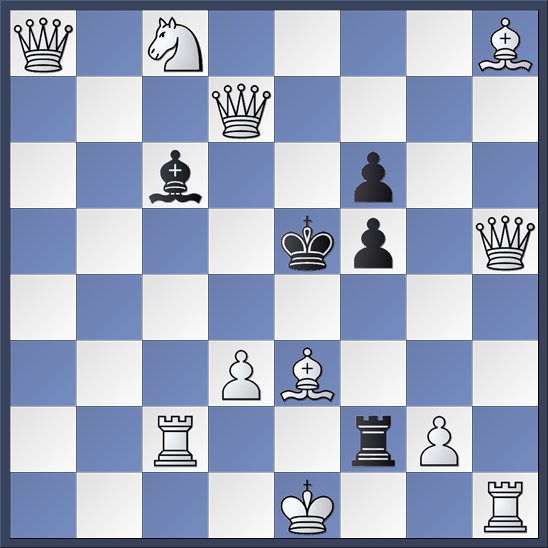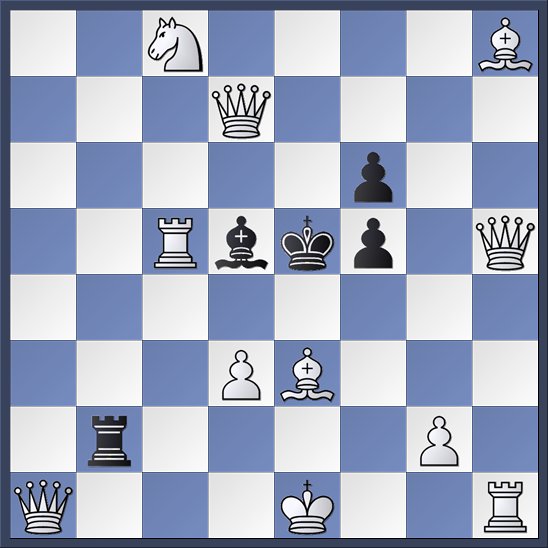Last week I introduced the idea of Allumwandlung, abbreviated AUW. This refers to a problem in which all four pawn promotions, to queen, rook, bishop and knight, appear in some way. The problem I showed last week was a crystal clear illustration of the theme, and deservedly won second place in the annual selfmate tourney in The Problemist magazine.
As it happens, the third place winner in that tourney also showed AUW, but it makes for quite a contrast with last week's problem. Whereas that showed impressive elegance and clear logic, this one is just a demented, brilliant mess. It was composed by Michael McDowell in 2012, and calls for selfmate in thirteen moves:

Recall that in a selfmate white plays first and forces black to give checkmate in the stipulated number of moves. Black, for his part, tries desperately to avoid giving mate. It's a complete inversion of normal chess logic!
Also keep in mind that when we write down chess moves, the vertical files are labeled a--h from left to right, while the horizontal ranks are numbered 1--8 from bottom to top. In this problem the white king starts on e1, while the black king starts on h8.
One challenge of composing selfmates is the need for strict control over both kings. The white king must end up checkmated, after all, while the black king is likely to be checked a lot as white makes black do his bidding. As a result, long selfmates like this usually have just one line, with lots of checks. But what a line! I'm sure you've noticed those six white pawns lined up on the seventh rank. It hardly counts as a spoiler to tell you that during the solution, all six of those pawns promote.
The solution begins with 1. f8Q+ Nxf8 2. exf8R+ Kg7

White had to start with the queen promotion, since g7 had to be covered. That forced black to take the queen with his knight to get out of check. But the second promotion is to a rook, since this time we specifically want black to have a flight square on g7.
The solution continues: 3. h8B+ Kxf8 4. b8Q+ Ke7

Of course, promoting to a queen instead of a bishop on move three would have given checkmate, which is not what we want! This is the wonderful world of selfmates we're talking about. So the bishop promotion was called for. There's also an element of paradox in the fact that the black king has been driven out of the corner. You might think that would make the king harder to control. But we're just getting started. It's not at all clear how white's king is going to end getting mated, and the black king has a lot more wandering to do.
Play continues: 5. Qbe8+ Kd6 6. c8N+ Kd5

With the knight promotion white has completed the AUW. But there is much more to come. 7. a8Q+ Bc6 8. Qxd7+ Ke5:

You have to love a position where white has three queens and two dark-squared bishops. We're eight moves in, and still no sign of how white is going to be mated. But stay with me just a bit longer. 9. Rc5+ Bd5 10. Qa1+ Rb2

11. Qh2+ f4

Now we're ready for the big finale. Things are about to start happening quickly, so pay attention. Blink and you'll miss it! 12. g4 fxg4 e.p. 13. 0-0 gxh2 mate.

Pretty cool, don't you think! I mentioned that this problem shows AUW, but if you look closely there's something else that's interesting. There are three “special” moves in chess: pawn promotion, castling and en passant. All three of those moves are shown in this problem. Showing all three of these moves in one problem is known as the Valladao task. There are very few examples of this task in selfmates form, adding to the interest of this problem.
See you next week!

I don't play much chess but I've been following this series with interest, and this is definitely my favourite problem so far - not so much for the AUW but for the finish. Did not see that coming!
Surely this deserved 2nd prize ahead of the last one ;)
As with any art form, rankings are very subjective. Last week's problem and this week's problem are very different, making them difficult to compare directly. They're both really good, though.
In a self-mate tourney, is it better to place third than second?
Kinda funny -- I actually thought I'd take a shot at solving this. And, after staring & contemplating a few moments, believe it or not I started off looking at 1. f8Q+ Nxf8 2. exf8R+ Kg7.
But -- I began telling myself "nah, White's probably gonna need the Knight to survive to mate him." And my inclination for allowing poor assumptions to direct me once again led to failure.
Anyhow, GREAT problem. And a highly interesting feature to this series, for me, is the discovery that there is a Dirk Gently fan following the trail! Ah, the interconnectedness of all things.....Last time I read the first Dirk I recall wondering if it was, in some ways, the very best book ever written. In a fit of creative chaos I took all the letters in the poem Jabberwocky and rearranged them to form a tribute verse to Douglas Adams. I fired it off to a fanzine and the editor liked it, anyhow.
Keep 'em coming, Jason.